新四级翻译之--语序调整
四六级汉译英技巧(学生版)
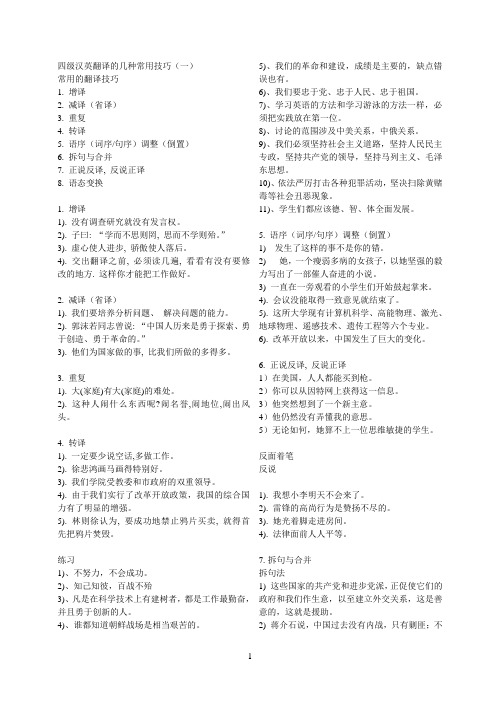
四级汉英翻译的几种常用技巧(一)常用的翻译技巧1. 增译2. 减译(省译)3. 重复4. 转译5. 语序(词序/句序)调整(倒置)6. 拆句与合并7. 正说反译, 反说正译8. 语态变换1. 增译1). 没有调查研究就没有发言权。
2). 子曰: “学而不思则罔, 思而不学则殆。
”3). 虚心使人进步, 骄傲使人落后。
4). 交出翻译之前, 必须读几遍, 看看有没有要修改的地方. 这样你才能把工作做好。
2. 减译(省译)1). 我们要培养分析问题、解决问题的能力。
2). 郭沫若同志曾说: “中国人历来是勇于探索、勇于创造、勇于革命的。
”3). 他们为国家做的事, 比我们所做的多得多。
3. 重复1). 大(家庭)有大(家庭)的难处。
2). 这种人闹什么东西呢?闹名誉,闹地位,闹出风头。
4. 转译1). 一定要少说空话,多做工作。
2). 徐悲鸿画马画得特别好。
3). 我们学院受教委和市政府的双重领导。
4). 由于我们实行了改革开放政策,我国的综合国力有了明显的增强。
5). 林则徐认为, 要成功地禁止鸦片买卖, 就得首先把鸦片焚毁。
练习1)、不努力,不会成功。
2)、知己知彼,百战不殆3)、凡是在科学技术上有建树者,都是工作最勤奋,并且勇于创新的人。
4)、谁都知道朝鲜战场是相当艰苦的。
5)、我们的革命和建设,成绩是主要的,缺点错误也有。
6)、我们要忠于党、忠于人民、忠于祖国。
7)、学习英语的方法和学习游泳的方法一样,必须把实践放在第一位。
8)、讨论的范围涉及中美关系,中俄关系。
9)、我们必须坚持社会主义道路,坚持人民民主专政,坚持共产党的领导,坚持马列主义、毛泽东思想。
10)、依法严厉打击各种犯罪活动,坚决扫除黄赌毒等社会丑恶现象。
11)、学生们都应该德、智、体全面发展。
5. 语序(词序/句序)调整(倒置)1) 发生了这样的事不是你的错。
2) 她,一个瘦弱多病的女孩子,以她坚强的毅力写出了一部催人奋进的小说。
英语专业四级翻译词序处理

英语专业四级翻译词序处理单词的顺序在英语翻译中是一个非常重要的问题。
不同于中文的语序,英语语法对词序有严格要求。
正确的词序对于翻译的准确性和流畅性都至关重要。
本文将介绍几种常见的词序处理方法,以帮助英语专业四级考试中的翻译题。
1. 主谓宾结构英语中主谓宾结构是最基本的语法结构,一般遵循主语 + 谓语动词+ 宾语的顺序。
在中文翻译成英语时,应保持相同的顺序。
例如:中文:他喜欢读书。
英文:He likes reading.2. 物质的处理当中文中存在表示物质的名词时,应将其置于动词之后。
例如:中文:他吃了一个苹果。
英文:He ate an apple.3. 地点状语的处理地点状语一般将其放在句末或者句首。
例如:中文:他在图书馆里学习。
英文:He studies in the library.4. 时间状语的处理时间状语可以放在句子的开始、中间或者结尾。
例如:中文:我明天要去北京。
英文:Tomorrow, I will go to Beijing.或者:I will go to Beijing tomorrow.5. 倒装句的处理当英语中遇到否定词或表示条件的词语时,一般需要使用倒装句。
例如:中文:如果下雨,我们就不去公园。
英文:If it rains, we won't go to the park.6. 并列谓语的处理并列谓语中,根据表述的先后顺序,一般将谓语动词排列在前,然后是宾语或其他成分。
例如:中文:他学习英语,也学习法语。
英文:He studies English and learns French.7. 现在分词的处理现在分词在句子中作为定语或状语时,一般放在名词或代词之后。
例如:中文:他正在看电视的时候,电话响了。
英文:While he was watching TV, the phone rang.以上是英语专业四级翻译中常见的词序处理方法,翻译时一定要注意词序的准确性和合理性,从而使翻译更加流畅和符合英语语法规则。
翻译汉译英之语序调整

一、句内的语序调整
1. 句内主要成分位置的调整 2. 状语位置的调整 3. 一系列表示时间、地点、方式状语位置 的调整 4. 定语位置的调整
1. 句内主要成分位置的调整
英汉语的基本语序: 主语+谓语+宾语 施事+行为+受事 就施事、行为和受事的顺序而言,汉语语序排列比 英语灵活。 施事、行为、受事的位置:汉语:比较自由 英语:比较固定 中国批评界怎样的趋势,我却不大了解,也不很注 意。 I am not too clear, not too interested,either, regarding current trends in China’s literary criticism.
沙发上坐着一个人。 A man was sitting on the couch. 马可波罗的中国之行,给他留下最深刻印象 的是杭州西湖之秀美。 The beauty of the West Lake in Hangzhou was what impressed Marco Polo most during his trip to China.
2. 状语位置调整
汉语:状语一般位于主语和谓语之间,呈主 语—状语—谓语—宾语模式。
他ห้องสมุดไป่ตู้晚都要看电视。
有时为了强调,也可放在主语之前,如:
几十年来,我经常想到这一只狗,直到今天, 我一想到它,还会不自主地流下眼泪。
英语:状语一般出现在宾语后的句尾,呈主 语—谓语—宾语—状语模式。 He watches TV every evening. 有时也可出现在句首或句中 They observed with great care the chemical reaction. In a machine a great deal of energy is lost because of the friction between its parts.
英语专业四级翻译句式调整
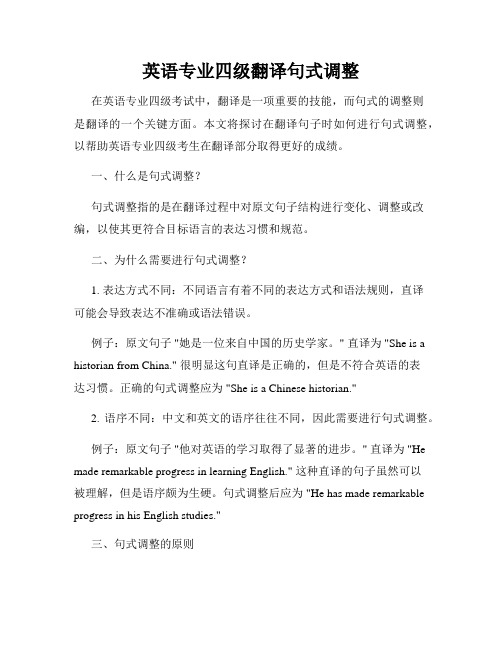
英语专业四级翻译句式调整在英语专业四级考试中,翻译是一项重要的技能,而句式的调整则是翻译的一个关键方面。
本文将探讨在翻译句子时如何进行句式调整,以帮助英语专业四级考生在翻译部分取得更好的成绩。
一、什么是句式调整?句式调整指的是在翻译过程中对原文句子结构进行变化、调整或改编,以使其更符合目标语言的表达习惯和规范。
二、为什么需要进行句式调整?1. 表达方式不同:不同语言有着不同的表达方式和语法规则,直译可能会导致表达不准确或语法错误。
例子:原文句子 "她是一位来自中国的历史学家。
" 直译为 "She is a historian from China." 很明显这句直译是正确的,但是不符合英语的表达习惯。
正确的句式调整应为 "She is a Chinese historian."2. 语序不同:中文和英文的语序往往不同,因此需要进行句式调整。
例子:原文句子 "他对英语的学习取得了显著的进步。
" 直译为 "He made remarkable progress in learning English." 这种直译的句子虽然可以被理解,但是语序颇为生硬。
句式调整后应为 "He has made remarkable progress in his English studies."三、句式调整的原则1. 保持信息准确:句式调整的目的是为了更好地传达原文的意思,因此在调整句式时应尽量保持信息的准确性。
2. 根据上下文调整:句子的意思受到上下文的影响,因此在句式调整时需要考虑上下文的语境,以保证翻译的连贯性。
3. 符合语法规则:句式调整需要符合目标语言的语法规则和表达习惯,以保证翻译的流畅性和自然性。
四、常见的句式调整方法1. 主动变被动:如果原文中为主动语态,而目标语言表达习惯使用被动语态,则可以将句子改为被动语态。
英语四级高分翻译技巧:换序译法

英语四级高分翻译技巧:换序译法英语四级高分翻译技巧:换序译法英语四六级考试最核心重点的内容是做题,做透题可以轻松通过英语四六级考试。
下文是为大家精选的英语四级高分翻译技巧:换序译法,欢迎大家阅读。
语序是指句子成分的排列次序。
汉语是分析型的语言,语序比较固定;而英语则是分析、综合参半的语言,语序比较灵活。
英语和汉语在基本语序上大同小异。
相同的是主语、谓语和宾语的位置,不同的是状语和定语的位置。
所以,在汉译英时,必须考虑到英语读者的思维习惯,适当地将译文的语序进行转换调整。
汉译英时的换序主要包括主语、谓语、宾语、定语、状语等的换序。
请看下面的例子:例1.【试题原句】大多数包裹里装着网上订购的'物品。
(2015年6月四级真题)【思路分析】句子主干为“……包裹里装着……物品”,“大多数”作定语,修饰“包裹”;“网上订购的”为定语,修饰“物品”,翻译时可处理为定语从句,也可处理为过去分词作后置定语。
这里的“物品”是泛称,所以用“item”表示。
【参考译文1】Most packages contain the items that are ordered online.【参考译文2】Most packages contain the items ordered online.【技巧探秘】本句的翻译涉及到了定语的换序。
中文原句的主干为“……包裹里装着……物品”,其中“网上订购的”为定语,修饰“物品”。
虽然汉语中定语通常放在名词之前,但在英语中,词组或从句作定语时则要放在名词之后,以符合英文的表达习惯和思维方式。
因此,可以将定语“网上订购的”翻译时可处理为定语从句,或处理为过去分词作后置定语。
(如参考译文1和2所示)例2.【试题原句】有些教育工作者2003年就建议设立全民读书日。
(2014年6月四级真题)【思路分析】本句主干部分为“……教育工作者……建议设立全民读书日”。
“有些”作定语,修饰主语“教育工作者”;谓语“建议”可套用suggest doing sth.或suggest sth.的句式,也可用suggest+从句将其译出,但要注意从句适宜用should+do的虚拟语气,其中should经常被省略。
英语翻译中的语序调整

英语翻译中的语序调整语序调整是翻译中最重要的方法之一,本文中,跨考教育英语教研室周老师为考生详细解析翻译中的语序调整,希望对考生英语复习有所帮助。
(一) 确定主语,调整语序。
英语为主语显著的语言,主语突出,除省略句以外,一般情况下每个句子都有主语;句法重形合,要求句子各成分特别清楚,以免结构混乱,影响句意。
而汉语则是主题显著的语言,主题突出,主语不突出;句法重意合,指代关系在形式上不明显。
在篇章中,某些句子的主语常常可以省略,有时必须省略;有些主语难以一眼看清,需要读者用心识别。
因而在英译汉过程中,确定主语,调整句序往往是一个需要动脑筋的问题。
例如:(1) Nightfall found him many miles short of his appointed preaching place.这句话按原文的语序,Nightfall (夜幕) 作主语,按原语序照样翻译下去,译文会显得别扭,不自然。
按照汉语的语言习惯,应选用“他”作主语,因而正确的翻译是:夜幕降临时,他离预定的布道地点还有好多英里路。
又如:(2)As is known to all ,2003 saw the successful launching ofChina’s first manned spaceship.这句话可译为:众所周知,中国在2003 年成功地发射了第一艘载人宇宙飞船。
原文主语是“2003”,但译文没有以“2003”作主语,而以“中国”这一行为主体作主语。
用时间作主语是英语中较为常见的现象,这种用法不仅强调了时间的观念,而且也使句子简洁、生动。
按照西方人的思维模式和英语表达习惯,英语还可以用地点等名词作主语。
如:Nanjing witnessed many great historic events. (在南京城发生过许多重大的历史事件。
)在英汉翻译过程中,之所以产生这样的问题是因为英汉两种语言的语法结构、行文习惯、思维模式不同。
常用翻译技巧——语序调整

例5. Read, then, the following essay which undertakes to demonstrate that logic, far from being a dry, pedantic (迂腐)discipline, is a living, breathing thing, full of beauty and passion.【主次】 下面这篇散文,说明逻辑学一点都不枯燥迂腐, 反而清新活泼,富于美感和激情。诸位不妨一 读。【次主】 Jerry说:essay不一定是散文,就是文章。况 且散文怎么好跟逻辑学联系在一起。
home.
调整语序:离开家之前我扫了地,关了窗,
断了电。
顺译:我扫了地,关了窗,断了电,然后才出门。
12 12
12 9
12
10
例5. Read, then, the following essay which undertakes to demonstrate that logic, far from being a dry, pedantic (迂腐)discipline, is a living, breathing thing, full of beauty and passion.
Jerry说:其实这个例句不调整语序也可以翻 的很好。
读了下面这篇文章你就会发现逻辑学不仅不 枯燥迂腐,反而清新活泼,富于美感和激情。
12 11
实战练习 I swept the floor, closed the window and
cut the electricity the door before leaving
12Байду номын сангаас
7
翻译技巧之语序调整法
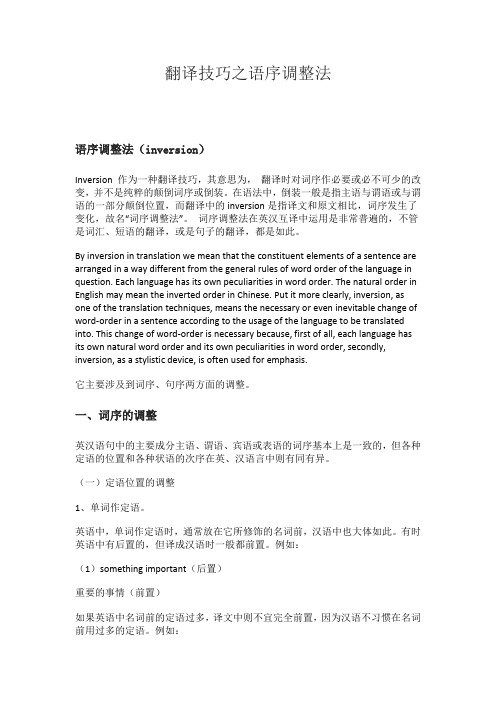
翻译技巧之语序调整法语序调整法(inversion)Inversion 作为一种翻译技巧,其意思为,翻译时对词序作必要或必不可少的改变,并不是纯粹的颠倒词序或倒装。
在语法中,倒装一般是指主语与谓语或与谓语的一部分颠倒位置,而翻译中的inversion是指译文和原文相比,词序发生了变化,故名“词序调整法”。
词序调整法在英汉互译中运用是非常普遍的,不管是词汇、短语的翻译,或是句子的翻译,都是如此。
By inversion in translation we mean that the constituent elements of a sentence are arranged in a way different from the general rules of word order of the language in question. Each language has its own peculiarities in word order. The natural order in English may mean the inverted order in Chinese. Put it more clearly, inversion, as one of the translation techniques, means the necessary or even inevitable change of word-order in a sentence according to the usage of the language to be translated into. This change of word-order is necessary because, first of all, each language has its own natural word order and its own peculiarities in word order, secondly, inversion, as a stylistic device, is often used for emphasis.它主要涉及到词序、句序两方面的调整。
大学英语四级翻译七大技巧

大学英语四级翻译七大技巧大学英语四级翻译七大技巧大学英语四级一般指大学英语四级考试。
大学英语四级考试,即CET-4,College English Test Band 4的缩写,是由国家教育部高等教育司主持的全国性英语考试。
考试的主要对象是根据教育大纲修完大学英语四级的在校专科生、本科生或研究生。
下面是店铺整理的大学英语四级翻译七大技巧,欢迎阅览。
英语四级翻译技巧一:增词法在翻译段落时,为了能充分的表达原文含义,以求达意,翻译时有必要增加词语来使英文的表达更加顺畅。
例子:虚心使人进步,骄傲使人落后。
译文:Modesty helps one to go forward, whereas conceit makes one lag behind.批注:中间加上了增连词whereas,以使英语的句子表达更加有逻辑性。
英语四级翻译技巧二:减词英语的表达倾向简洁,汉语比较喜欢重复。
重复,作为一种汉语修辞方法,在某种场合下,重复的表达一个意思,是为了强调,加强语气。
为了有更强的节奏感和押韵,汉语中也经常会出现排比句。
考生在翻译这些句子时,为了符合英文表达的逻辑,就要有所删减或省略。
例子:这是革命的春天,这是人民的春天,这是科学的春天!让我们张开双臂,热烈拥抱这个春天吧!译文:Let us stretch out our arms to embrace the spring, which is one of the revolution, of the people, and of science.批注:如遇到重复的汉语排比句,汉译英时记得遵守英语的逻辑表达,用定语从句来翻译,使英文句子读起来也朗朗上口。
英语四级翻译技巧三:词类转换英语语言的一个很重要的特点,就是词类变形和词性转换,尤其是名词、动词、形容词之间的'转换。
例子:她的书给我们的印象很深。
译文:Her book impressed us deeply.批注:在这里汉语中的名词需转化成英语中的动词"impress"。
汉英翻译① 新四级

翻译①(一) 词的翻译1. 词义选择2. 词类转换3. 词的增补4. 词的省略5. 词的替代1.词义选择(1)语境词汉语有些词语的含义会因语境而发生微妙的变化,称之为“语境词”,应紧密结合上下文译成相应的词,不能按照原词的字面意思来译。
原文:手机刷新了人与人的关系。
译文:Cell phone have altered the relationship among people.分析:“刷新”此处实际是指“改变”,而并非是我们平常所指的含义,因此不宜译成refurbish或renovate,翻译为alter或change更恰当。
(2) 表意模糊的词原文:这所全国重点大学为社会输送了大批的人才。
译文:The national key university has prepared batches of qualified graduates for the society.分析:“输送”在句中是一个模糊笼统的词,具体说来是指“培养出”。
“人才”笼统,译为qualified graduates比较确切。
(3) 比喻词汇汉语有许多比喻词汇,表面意义和喻指含义完全不同,英译时应跳出机械对应的思维定式,动态地译出其潜在含义。
原文:老师答应给这几个学生“吃小灶”。
译文:The teacher has promised to give these students special tuition.分析:“吃小灶”在这里指的是“个别辅导”。
2.词类转换(1)动词→名词英语动词受到形态变化规则的严格限制,大量本应该由动词表达的概念,常需借助于名词,因为名词不受形态规则的束缚,使用相对灵活、方便。
原文:吃头两个主菜时,也是赞不绝口。
译文:You"ll be full of praise while eating the first two main courses.分析:英语中有大量抽象名词表示行为或动作意义advice, agreement, inheritance, knowledge, praise, use等。
新四级段落翻译技巧

段落翻译技巧(选词)
3. 比喻词汇 汉语中有许多比喻词汇,表面意义和喻指含义完全 不同。英译时应跳出机械对应的思维模式,动态地译出 其潜在的含义。 例1. 老师答应给这几个学生‚开小灶‛。 The teacher has promised to give these students special tuition.
段落翻译技巧(选词)
2. 动词转介词 例1. 这样,每个地方都有自己的传说,风俗也就 一代代流传了下来。 译文1: Thus, every place has its own legends and
tales, and its traditions and customs were passed on from generation to generation. 译文2:Thus, every place, with its own legends and tales, has its traditions and customs passed on from generation to generation.
新四级段落翻译技巧(句)
句的翻译 汉语句子断句不严,外形松散,因此形式自由、富 于弹性。而英语以‚主—谓‛的主干结构为中心来统领 各个语言成分,外形严谨,句界分明。 一、确立主干 1.确立主语 ⑴ 避免主语的机械对立 例1 这个地方比较多雨 译文1 It rains a lot in this area. 译文2 This area sees much rain. 译文3 There is much rain in this area. 分析 汉语主语的角度变化很少,而英语则变化较多。例 题原文的主语只能由‚这个地区‛担当,但在译成英文 时就有了多种选择。
新四级段落翻译技巧(句序)
英语翻译中的语序调整

英语翻译中的语序调整英语翻译中的语序调整语序调整是翻译中最重要的方法之一,本文中,跨考教育英语教研室周老师为考生详细解析翻译中的语序调整,希望对考生英语复习有所帮助。
(一)确定主语,调整语序。
英语为主语显著的语言,主语突出,除省略句以外,一般情况下每个句子都有主语;句法重形合,要求句子各成分特别清楚,以免结构混乱,影响句意。
而汉语则是主题显著的语言,主题突出,主语不突出;句法重意合,指代关系在形式上不明显。
在篇章中,某些句子的主语常常可以省略,有时必须省略;有些主语难以一眼看清,需要读者用心识别。
因而在英译汉过程中,确定主语,调整句序往往是一个需要动脑筋的问题。
例如:(1) Nightfall found him many miles short of his appointed preaching place。
这句话按原文的语序,Nightfall (夜幕) 作主语,按原语序照样翻译下去,译文会显得别扭,不自然。
按照汉语的语言习惯,应选用“他”作主语,因而正确的翻译是:夜幕降临时,他离预定的布道地点还有好多英里路。
又如:(2)As is known to all ,2003 saw the successful launching ofChina’s first manned spaceship.这句话可译为:众所周知,中国在2003 年成功地发射了第一艘载人宇宙飞船。
原文主语是“2003”,但译文没有以“2003”作主语,而以“中国”这一行为主体作主语。
用时间作主语是英语中较为常见的现象,这种用法不仅强调了时间的观念,而且也使句子简洁、生动.按照西方人的思维模式和英语表达习惯,英语还可以用地点等名词作主语.如:Nanjing witnessed many great historic events. (在南京城发生过许多重大的历史事件。
)在英汉翻译过程中,之所以产生这样的问题是因为英汉两种语言的语法结构、行文习惯、思维模式不同.英美人强调客观,常用物、抽象概念、非人称it 作主语,让事物以客观的口气呈现出来,使叙述显得公正、客观,结构趋于严密、紧凑,语气较为委婉、间接。
公文四级翻译技巧总结提高翻译准确性的方法

公文四级翻译技巧总结提高翻译准确性的方法翻译是一项需要高度准确性的工作,特别是在翻译公文时更是如此。
公文翻译不仅需要保持原文的意思准确无误,还需符合公文的格式和规范。
本文将总结一些提高公文翻译准确性的方法和技巧。
一、翻译前的准备工作在开始翻译公文之前,为了保证翻译的准确性和流畅性,需要进行充分的准备工作。
首先,熟悉公文翻译的格式和规范。
不同类型的公文可能有不同的格式要求,例如公告、通知、报告等,了解并遵循这些要求对于保持翻译的准确性非常重要。
其次,要了解公文所属的领域和专业术语。
公文往往涉及到一些特定的领域知识和专业术语,熟悉并掌握这些内容可以帮助我们更好地理解和翻译公文。
二、准确理解原文意思在进行公文翻译时,首要任务是准确理解原文的意思。
为了做到这一点,我们可以采取以下技巧:1. 仔细阅读原文:细致的阅读可以帮助我们全面把握原文的意思,理解作者的用词和表达方式。
有时,一段话可能需要多次阅读才能完全理解。
2. 分析语境:语境是理解原文意思的关键所在。
仔细分析原文所处的语境,包括上下文、前后句子及段落,可以帮助我们更好地把握原文的含义。
3. 留意关键词:一些关键词汇往往是理解原文的关键,我们可以通过标注或圈出这些词汇来提醒自己在翻译时予以重点注意。
三、遵循翻译原则在进行公文翻译时,我们应该遵循一些基本的翻译原则,以保证翻译的准确性和规范性。
以下是几个重要的原则:1. 词义准确:翻译时要确保词义准确无误,不偏离原文的意思。
可以使用各种词典和工具来辅助翻译,以保证使用的词语准确。
2. 语法正确:在翻译过程中,要注意保持语法的正确性。
语法错误可能会导致信息传达的不准确,影响整篇翻译的质量。
3. 文体恰当:公文通常有一定的正式性,因此在选择词语和表达方式时要注意恰当性,避免使用过于口语化或随意的表达方式。
四、积累专业术语和常用翻译技巧公文翻译经常涉及到一些专业术语,因此在翻译之前需要先了解所涉及领域的专业术语和常用表达方式。
新四级翻译之--语序调整PPT文档共36页

谢谢!
33、如果惧怕前面跌宕的山岩,生命 就永远 只能是 死水一 潭。 34、当你眼泪忍不住要流出来的时候 ,睁大 眼睛, 千万别 眨眼!你会看到 世界由 清晰变 模糊的 全过程 ,心会 在你泪 水落下 的那一 刻变得 清澈明 晰。盐 。注定 要融化 的,也 许是用 眼泪的 方式。
35、不要以为自己成功一次就可以了 ,也不 要以为 过去的 光荣可 以被永 远肯定 。
21、要知道对好事的称颂过于夸大,也会招来人们的反感轻蔑和嫉妒。——培根 22、业精于勤,荒于嬉;行成于思,毁于随。——韩愈
23、一切节省,归根到底都归结为时间的节省。——马克思 24、意志命运往往背道而驰,决心到最后会全部推倒。——莎士比亚
新四级翻译之--语序调整
31、别人笑我太疯癫,我笑他人看不 穿。(名 言网) 32、我不想听失意者的哭泣,抱怨者 的牢骚 ,这是 羊群中 的瘟疫 ,我不 能被它 传染。 我要尽 量避免 绝望, 辛勤耕 耘,忍 受苦楚 。我一 试再试 ,争取 每天的 成功, 避免以 失败收 常在别 人停滞 不前时 ,我继续拼搏 。
英语四六级翻译技巧之句子语序的调整

【导语】翻译和写作是在冲刺阶段⽐较容易的题型。
给⼤家分享四六级翻译技巧——句的翻译之语序调整。
语序可以根据定语的位置、状语的位置、汉英语⾔叙事重⼼不同、强弱词语的顺序不同以及否定转移等⽅式进⾏调整。
(1)定语的位置汉语的定语通常在修饰词之前,英语的定语位置分两种:前置和后置。
单词充当定语通常放在被修饰的中⼼词前;⽽短语和从句作定语则多置于所修饰的中⼼语之后。
钓鱼是⼀项能够陶冶性情的运动,有益于⾝⼼健康。
Fishing is an outdoor sport that can help cultivate your mind and it is good for our mental and physical health.【2014-6】⼀些为接受更好教育⽽转往城市上学的学⽣如今⼜回到了本地农村学校就读。
Some students who once transferred to urban schools for better education now return to the local rural schools.(定语后置)仅在11⽉11⽇,中国消费者就从国内的购物平台购买了价值90亿美元的商品。
Only on the November 11, Chinese consumers boughtthe goodsworth of $9 billion on the biggest shopping platform.(定语后置)【2015-6】中国是世界上最古⽼的⽂明之⼀。
China is one of the world’s most ancient civilizations.(前置定语)(2)状语的位置汉语按事情发⽣先后叙述,⽽英语中时间状语从句可在主句前,也可在主句后。
我吃了晚饭后出去散步。
I went out for a walk after I had my dinner.After I had my dinner, I went out for a walk.2011年3⽉⽇本核电站事故后,中国的核能开发停了下来。
翻译资格考试备考:英汉翻译技巧之语序的调整
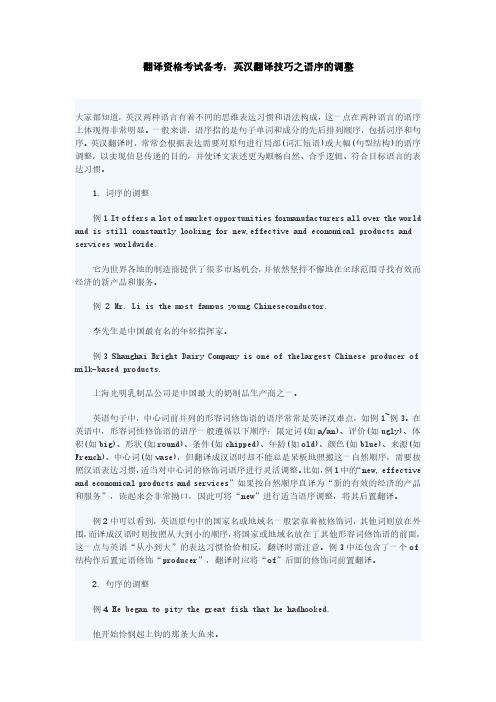
翻译资格考试备考:英汉翻译技巧之语序的调整大家都知道,英汉两种语言有着不同的思维表达习惯和语法构成,这一点在两种语言的语序上体现得非常明显。
一般来讲,语序指的是句子单词和成分的先后排列顺序,包括词序和句序。
英汉翻译时,常常会根据表达需要对原句进行局部(词汇短语)或大幅(句型结构)的语序调整,以实现信息传递的目的,并使译文表述更为顺畅自然、合乎逻辑、符合目标语言的表达习惯。
1.词序的调整例1It offers a lot of market opportunities formanufacturers all over the world and is still constantly looking for new,effective and economical products and services worldwide.它为世界各地的制造商提供了很多市场机会,并依然坚持不懈地在全球范围寻找有效而经济的新产品和服务。
例2Mr.Li is the most famous young Chineseconductor.李先生是中国最有名的年轻指挥家。
例3Shanghai Bright Dairy Company is one of thelargest Chinese producer of milk-based products.上海光明乳制品公司是中国最大的奶制品生产商之一。
英语句子中,中心词前并列的形容词修饰语的语序常常是英译汉难点,如例1~例3。
在英语中,形容词性修饰语的语序一般遵循以下顺序:限定词(如a/an)、评价(如ugly)、体积(如big)、形状(如round)、条件(如chipped)、年龄(如old)、颜色(如blue)、来源(如French)、中心词(如vase),但翻译成汉语时却不能总是呆板地照搬这一自然顺序,需要按照汉语表达习惯,适当对中心词的修饰词语序进行灵活调整。
翻译技巧:语序调整 形象的处理
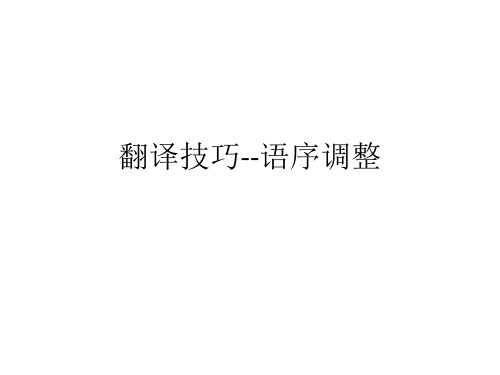
一、保留形象 【例1】现在不能削弱发达地区的活力,也不能鼓励吃“大锅 饭”。 At present we don‘t want to dampen the vitality of the developed areas or encourage the practice of having everyone“eat from the same big pot”. “吃大锅饭”如译成 sharing everything,receiving equal pay, egalitarianism,虽然意思基本准确,但丢失了原文的形象, 故平淡无味。上面的译文既保留了原文的形象,又传达了原 文的意思,因而优于不保留形象的译文。 【例2】资产阶级自由化有苗头出现时不注意,就会出事。 译文 1: If we neglect the symptoms of bourgeois liberalization, we may find ourselves in trouble. 译文2: If we don’t nip bourgeois liberalization in the bud, we may find ourselves in trouble. 原中文的“苗头”带有一定的形象,如仅译成symptoms(症 状),尤如一杯白开水。译文2改为nip...in the bud,形象生 动,跃然纸上,更能增强对读者的感染力。
翻译技巧--语序调整
翻译技巧--语序调整
• 语序反映语言使用者的思维模式。对同一客观 事物或事实,英汉有不同的语言表达顺序。翻 译时,应考虑到汉语读者的思维习惯,适当地 调整译文的词句顺序。调整主要涉及下列几个 方面:时空顺序、逻辑顺序、结构性调整等。 一、时空顺序 • 在一系列表示时间或地点的状语连用时,英 语倾向先小后大、由近及远的顺序,而汉语则 大体相反。翻译时应做适当调整。若时间、地 点和方式状语同时出现在句子中,英语的排列 顺序是:方式-地点-时间-动词,汉语的排列顺 序是:时间-地点-方式-动词。
- 1、下载文档前请自行甄别文档内容的完整性,平台不提供额外的编辑、内容补充、找答案等附加服务。
- 2、"仅部分预览"的文档,不可在线预览部分如存在完整性等问题,可反馈申请退款(可完整预览的文档不适用该条件!)。
- 3、如文档侵犯您的权益,请联系客服反馈,我们会尽快为您处理(人工客服工作时间:9:00-18:30)。
• 2). 表示条件(假设)与结果关系的英语复 合句中,条件(假设)与结果的顺序也不 固定,在汉语中则是条件在前,结果在后。 • I still hope you will come back if arrangements could be made.(后置) • 如果安排得好,我还是希望你来。(前置)
9/24/2014
琴棋书画
• 中国人最懂得消遣,中国从前的读书人,闲 暇时间以琴棋书画作为消遣。在中国人看来,艺 术品的好坏,意味着作者人格的高低,所以弹琴、 下棋、写字和绘画,都代表着一个人的修养。弹 琴不是要做音乐家,而是随着美妙的琴声,进入 一个辽阔的世界,净化自己的心灵。下棋不是为 了胜负,而是磨练耐性和使人眼光远大。写字不 仅是把字写漂亮,同时也是为了陶冶情操。绘画 则是借着画面上的简单线条,表现自己的想象的 世界。
9/24/2014
• 2). 英语复合句中有时包含两个以上的时间 从句,各个时间从句的次序比较灵活,汉 语则一般按事情发生的先后安排其位置。
• He had flown yesterday from Beijing where he spent his vocation after finishing the meeting he had taken part in Tianjin. • 他本来在天津开会,会议一结束,他就去 北京度假了,昨天才坐飞机回来。
9/24/2014
状语位置调整小技巧
• 表示时间,地点,方式状语位置的调整
• 汉语 : • • 英语:
时间→地点→方式→动词 动词→方式→地点→时间
9/24/2014
连连看吧!
• 大会将于①今年九月②在北京③隆重开幕。 • The meeting will begin ceremoniously in Beijing the following September.
9/24/2014
• • • • •
5) 他们很细心地观察化学变化。 They observed the chemical reaction with great care. They observed with great care the chemical reaction. 6) 他们肩并肩地以疯狂速度向那座石塔奔去。 They ran side by side at a fantastic speed towards the stone pagoda. • Side by side and at a fantastic speed they ran towards the stone pagoda. • Side by side they ran at a fantastic speed towards the stone pagoda.
9/24/2014
定语位置的调整
• • • • • • • • 简单的定语无需调整 如: 浩瀚的大海 The vast sea 古老的中原文化 The time-honored Central Plain culture 举世闻名的万里长城 The world-famous Great Wall
9/24/2014
9/24/2014
定语位置调整小技巧
• 1. 单词作定语。
• a.英语中,单词作定语时,通常放在它所修饰的 名词前,汉语中也大体如此。有时英语中有后置 的,译成汉语时一般都前置。 • 重要的事情(前置) • something important(后置)
9/24/2中则不宜 完全前置,因为汉语不习惯在名词前用过多的定 语。
9/24/2014
2.英汉语复合句中的逻辑顺序的调整
• 1). 表示因果关系的英语复合句中,因果顺 序灵活,在汉语中多数情况是原因在前, 结果在后。 • He had to stay in bed because he was ill.(后置) • 因为他病了,他只好呆在床上。(前置)
9/24/2014
Nida 1969
1.
语序 –
调整
2.调 整语 序小 技巧
3.调 整语 序练 习
The Theory and Practice of Translation
调整 语序 • 语序:指句子各成分之间以及句与句之间 的排列次序,反映语言使用者的逻辑思维 和心理结构模式。
• 语序调整:1.句内语序(状语、定语) • 2.句间语序
9/24/2014
1.句内语序
• 请同学们体会一下汉英语序的不同吧!
• 沙发上坐着一个人。 • A man was sitting on a couch. • 马可· 波罗的中国之行,给他留下最深刻印象的是 杭州西湖之秀美。 • The beauty of the West Lake in Hangzhou was what i mpressed Marco Polo most during histrip to China.
9/24/2014
• • • • • • •
1) 我们明天上午九时动身。 We are going to start at nine tomorrow morning. 2) 这本书是三天前买的。 The book was bought three days ago. 3) 他每晚都要看电视。 He watches TV every evening. 4) 在机器中很多能量是由于部件之间的摩擦而损 失的。 • In a machine a great deal of energy is lost because of the friction between its parts.
9/24/2014
句内语序--英汉差别
• • • • • 英、汉相同点: “主语+谓语+宾语”(SVO) “施动+行为+受动” 英、汉相异点: 句内的语序的灵活性,以及定语、状语等 次要成分位置的差异。
9/24/2014
★
2.句内语序调整:状语和定语
• 状语位置的调整 • • • • 汉语状语位置:在主语和谓语之间。 “主语→状语→谓语→宾语” 英语状语位置:在宾语后的句尾。 “主语→谓语→宾语→状语”
体会一下下面的这些定语吧
• 一九四九年解放以前,中国人民曾经遭受①世界罕见的② 恶性通货膨胀的灾祸。 • Before liberation in 1949 the Chinese people suffered from ② some of the worst inflation ①the world had ever known. • ①中国现存②规模最大③保存最完好的古代建筑群。 • ③the best-preserved ② magnificent ancient architectural complexes ①in China
9/24/2014
句间语序的调整
• 句间语序:指复合句中主句和从句的时间和 逻辑关系叙述的顺序。 • 1.时间顺序的调整。
2.英汉语复合句中的逻辑顺序的调整。
9/24/2014
1.时间顺序的调整
• 1).英语复合句中,表示时间的从句可以放 在主句之前,也可以放在主句之后,汉语 中则通常先叙述先发生的事,后叙述后发 生的事。 • I went out for a walk after I had my dinner.(从句在主句之后) • 我吃了晚饭后出去散步。(从句在主句之 前)
9/24/2014
• 3. 表示目的与行动关系的英语复合句中,目 的与行动的顺序比较固定,多数是行动在前, 目的在后,汉语也如此,但有时为了强调, 也可把目的放在行动之前。 • Better take your umbrella in case it rains.(后 置) • 最好带上伞以防下雨。(前置)
• 他①每晚②都在图书馆③用心读书。 • He reads hard in the library every evening.
9/24/2014
• 他①一九三五年②八月③二十二日④早晨⑤六点三 十分诞生在⑴湖南的⑵一个小县城。 • He was born in a small town of Hunan Province at s ix thirty on the morning of August 22, 1935.
9/24/2014
• 1.中国人最懂得消遣,中国从前的读书人, 闲暇时间以琴棋书画作为消遣。 定语 • ★Know recreation best
• 设在位于①纽约市②中心③一座摩天大楼④第四十 层楼里的⑤那间办公室,就是他工作的小天地。 • The office on the fortieth floor of a skyscraper in the center of New York City is the world he works in.
TRANSLATION CET4 (调整语序)
翻译技巧
1 主语的选择 6 减译法 2 无主句的翻 译 7 增译法 3 调整语序 8 合并译法 4 词性转换 9 “让”字句 的译法 5 动词时态的 翻译 10 “使”字句 的译法
9/24/2014
调整语序
Translation consists in reproducing in the receptor language the closet natural equivalent of the sourcelanguage message, first in terms of meaning and secondly in terms of the style.
• 一个要饭的,身材矮小,面黄肌瘦,衣衫褴褛。 (后置) • a little, yellow, ragged beggar(前置)
9/24/2014
• 2. 短语作定语。 • 英语:修饰名词的短语一般放在名词之后, 汉语:名词之前,但间或也有放在后面的, 视汉语习惯而定。 • • • • 他们渡江的企图(前置) their attempt to cross the river(后置) 十进制计算法(前置) the decimal system of counting(前置)
